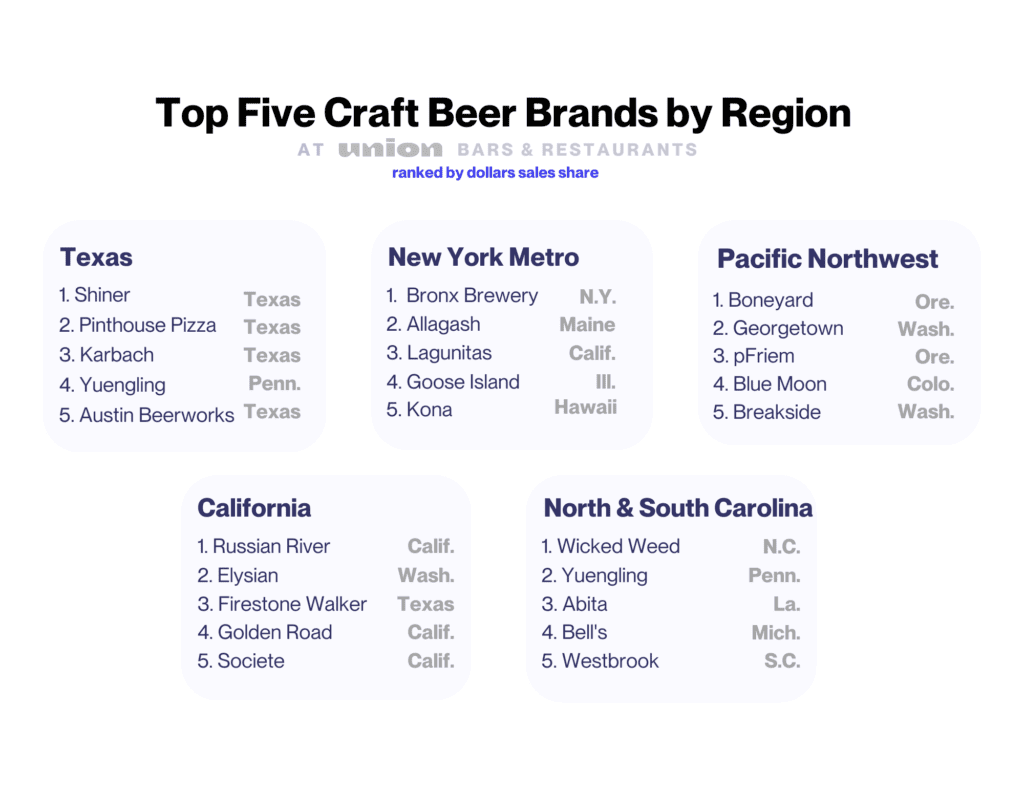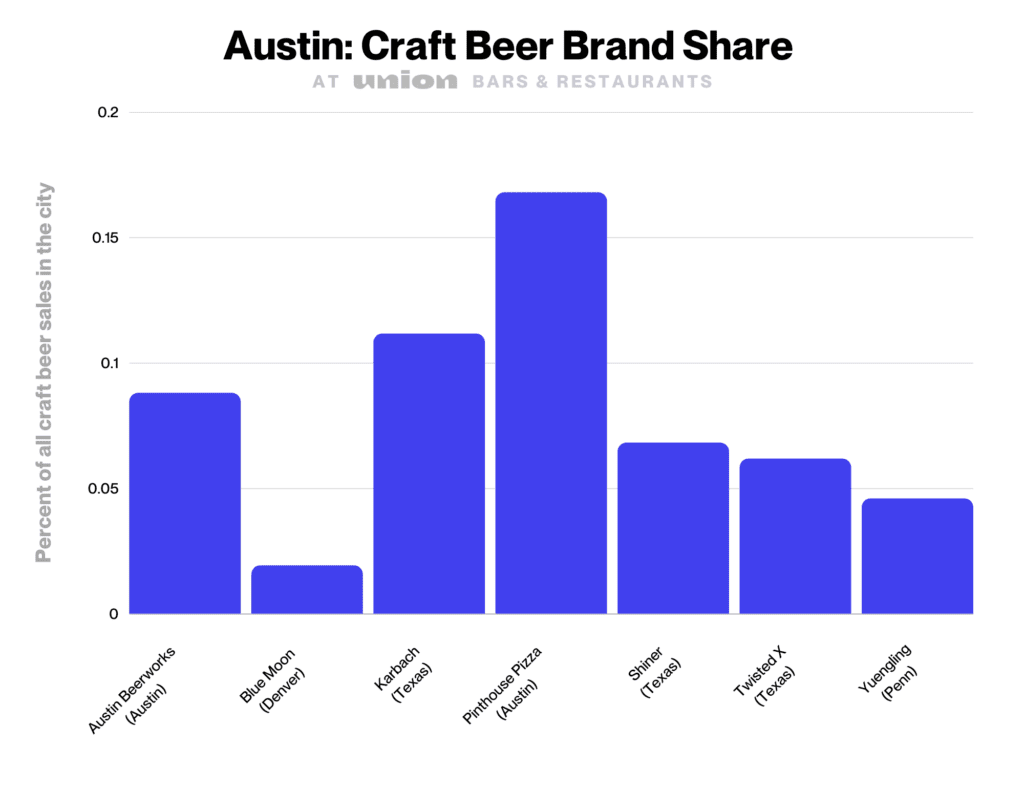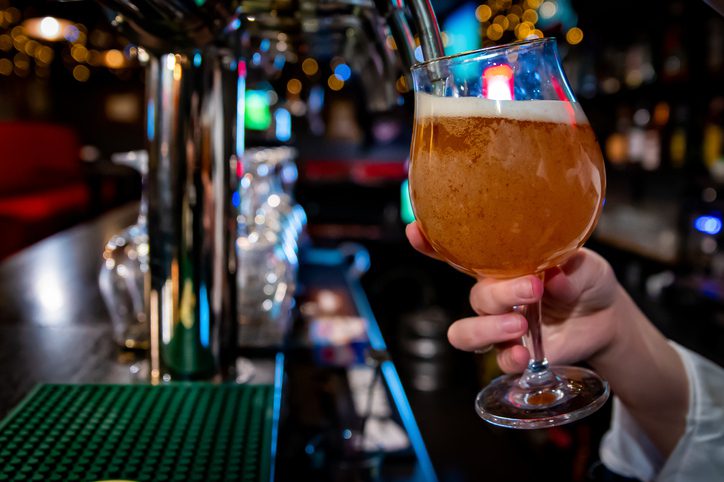Want to improve your Craft Beer sales? Focus on local brews in addition to regional favorites. That’s a key takeaway from Union‘s Craft Beer sales over the past year. Our findings show that medium-sized Craft Beer brands with regional resonance are popular. At the same time, hyper-local microbrewery brands also have outsized presence at Union bars and restaurants.
“Just as no two Craft Beers are alike, no two venues are alike when it comes to what craft brands they offer, and which sell best,” says Layne Cox, Union’s Chief Marketing Officer. “There’s an element of discovery at play for craft customers. It makes sense given that a big appeal of Craft Beer is its smaller-scale production and diversity of tastes and textures, compared to commercial beer brands.”
To get a closer look at Craft Beer consumption in on-premise venues, we looked at actual guest purchases at high-volume bars and restaurants over a year-long period, ending March 31, 2023. For a category that represents 24 percent share of all Beer/RTD sales at Union venues, these insights offer operators and brands fresh ideas to help them position their own Craft Beer menu strategy for success.
Regional Craft Beer Brands Show Sales Strength
Distribution logistics are always a factor for craft consumption, though the ongoing consolidation of Craft Beer gives some brands an advantage. We tracked the top-performing brands across Union venues and found a genuine mix of Craft Beer brands, from large- and medium-sized brands to local microbrews. Below, we share the top brands in select U.S. regions.
Top Craft Beer Brands at Union Venues
Note that Union’s criteria for Craft Beer takes consumer perception into consideration, as an increasing number of independent breweries are being acquired by larger-scale breweries, but they are still operated and marketed as independent brands.

Given Craft Beer’s venue-by-venue skew, it’s hard to generalize why one Craft Beer brand outsells another. But Union’s data shows that higher-volume venue operators prefer medium-sized brands like Allagash and Karbach over the larger Craft Beer brands. It’s potentially an indicator that these medium-sized brands help round out the overall beer menu, serving Craft Beer that’s still highly recognizable regionally, but not quite mainstream.
Hyper-Local Craft Beer Brands Can Have Outsized Presence
Every bar and restaurant is unique, and Craft Beer represents an opportunity to express a venue’s brand identity to customers. At Union venues, a smattering of microbrewery brands like Bronx Brewery, Austin’s Pinthouse Pizza, Austin Beerworks, and Coney Island show significant strength. As the data shows in this chart of Austin brand share, niche brands can have outsized sales presence right alongside regional brews like Karbach and Twisted X, both made in Texas. Notably, Blue Moon and Yuengling, some of craft’s biggest brands, showed lower share of the Craft Beer market in Austin.

With Texas-based Craft Beer brands performing so strongly in the Austin market, a key takeaway is that brewpubs and taprooms can bring the heat to the Craft Beer scene. They represent serious competition even for established medium-sized players like Karbach and Shiner. For a growing Craft Beer brand, the sales implications are significant. Showing strength in one’s local market is a core tenet of brand building.
Craft Beer Brands Matter to Operators
Bars and restaurants are a great place for customers to try new Craft Beer. Buying a pint or a single bottle at a venue is a much lower commitment compared to purchasing a four- or six-pack at retail. Larger venues tend to offer dozens of beers on their menu, so the concept of novelty and discovery is a big factor for on-premise customers.
“We often see customers more willing to trial and experiment with new brands in on-premise, which both makes them willing to try smaller brands and makes local a filter for decision making,” says Bart Watson, Chief Economist at the Brewers Association. “On-premise is about experience, and having a beer that connects to that venue and location may enhance that experience. Having the same beer you have in your fridge at home may not be what you’re looking for when you choose a venue with more choices.”
In reality, there are a variety of reasons a venue chooses one brand over another, and regionality is just one factor. Every venue takes a unique approach. The Phoenix, a Union venue in Houston, showcases a broad range of selections, from Bud Light and Dos Equis Lager to Karbach Hopadillo IPA and Parish Strawberry Mochi. Whereas Stout, a Union venue in New York City, carries more than 50 beers at each of its four locations. Its selections are nearly all craft, ranging from Brooklyn Brewery’s Pulp Art Hazy IPA to Cigar City’s Jai Alai IPA, from Tampa, Florida.
On average at Union venues, nearly half of the beers offered are craft. But at spots where Craft Beer is the focus, the number can rise to more than 100 Craft Beers on the menu. At Washugal Times Restaurant and Lounge, just outside of Portland, Oregon, the Union venue carries several Craft Beer taps from Seattle. “I don’t think people are coming to us for any one specific beer … I think they’re coming because we keep it local and change things up pretty frequently,” explains owner Ben Jackson.
Nearby in Portland, Tyler Treadwell of Tulip Shop Tavern and Lollipop Shoppe says it’s important to him to support brands that he believes have good values. The owner and hospitality veteran wants to educate his customers about those brands, and he goes out of his way to get them. “[Our customers] might see something they are unfamiliar with and, if they trust us, they’ll be excited to try something new,” Treadwell says. Still, taste preferences are always top of mind. “In general, good, clean lagers and fresh IPAs sell the best. And that’s what most people are drinking,” he says.
There’s some influence from brand reps, says Chaianya Damle, the regional director of Idle Hands and Parlor and Yard in Austin, but it’s not the primary driver. “We stick to local brands that we feel represent Texas and Austin well. Live Oak Hefeweizen and Austin Beer Works Pearl-Snap Pilsner sell consistently at these locations. “A recognizable tap handle makes for easy selling,” Damle says.
Sales Opportunities: Leverage Craft Beer’s Solid Reputation
“A bar that focuses on craft shouldn’t have the same tap list as a casual sports bar or a family-focused restaurant. Craft is certainly critical to any modern beer list, but how many and what types are going to vary by location and business model,” says Watson. He adds, “The one thing I will say with certainty is that as your beer list grows, your staff education and the need to help the customer grows.”
With Craft Beer comprising about a quarter of all beer sales at Union venues, it’s important that brands and operators alike work together to optimize product offerings. A strong Craft Beer program will balance out the well-known, larger brands with medium-sized regional favorites and novel, new products to encourage experimentation — a win-win for venues and brands alike.
Recommendations for Venues
- Let Your Location be Your Guide – What does your Craft Beer selection say about your venue’s local and regional identity?
- Stock a Mix of Big Craft and Hyper-Local Brands – Offer recognizable Craft Beer brands along with local beers, mix it up often, and teach your staff how to sell them.
- Know What’s Happening at Your Venue – Dig into your own venue’s Craft Beer trends, and experiment to see what works best with your customer base.
Recommendations for Brands
- Build That Hometown Pride – Position your brand story and distribution to establish a strong local following that will then help you expand organically, such as local events and sports clubs.
- Lean Into Local Character – Brews with a strong regional presence tend to sell well in the areas with which they’re associated.
- Give Them Something to Remember – Suggest a memorable serving glass and garnish so customers can associate your brand with a brand-specific experience.


